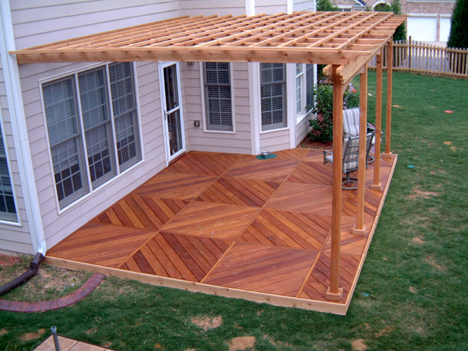When comparing Ipe decking to Cedar, several distinct advantages emerge, largely due to Ipe’s intrinsic properties as a tropical hardwood. Here’s an overview of the benefits Ipe decking offers over Cedar:
Durability and Longevity
-
Ipe:
Known for its exceptional durability, Ipe is incredibly resistant to rot, decay, and insect infestation, including termites. It is one of the most durable decking materials available, with a lifespan of up to 40 years or more with proper maintenance, even without chemical treatments.
-
Cedar:
While Cedar is naturally resistant to rot and decay to some extent and is more durable than some other softwoods, it doesn’t match the longevity or resistance of Ipe. Cedar is a softwood. Cedar typically lasts around 15 to 20 years, depending on environmental conditions and continuing maintenance.
Aesthetics and Maintenance
-
Ipe:
Ipe provides a sophisticated, opulent appearance, featuring deep color variations from olive brown to almost black, influenced by the wood’s oil content and age. It can naturally age to a silver-gray patina or be treated with oil to maintain its original hue. It requires less frequent maintenance compared to Cedar but may need periodic oiling to maintain its color if desired.
-
Cedar:
Known for its beautiful natural color, ranging from light amber to deep honey brown, Cedar also weathers to a silver-gray if not stained or sealed. It requires more maintenance, including regular staining or sealing to preserve its color. Regular staining or sealing is required for longer life and protect it from the elements.
Environmental Impact
-
Ipe:
The harvesting of Ipe wood has raised concerns about deforestation and environmental impact in South American forests. However, sustainably sourced Ipe, certified by organizations like the Forest Stewardship Council (FSC), is available and reduces environmental impact. Additionally, beyond FSC certification, Ipe is regulated by the US Lacey Act
-
Cedar:
Cedar is considered more sustainable than Ipe, especially if sourced from well-managed forests in North America. Its environmental impact is considered lower compared to the importation and harvesting practices associated with Ipe.
Cost
-
Ipe:
Generally, Ipe is more expensive than Cedar due to its durability, hardness, and aesthetic qualities. The initial cost is higher, but its longevity makes it more cost-effective in the long run.
-
Cedar
Cedar wood is less expensive than Ipe and does offer a beautiful aesthetic and decent durability for its price. The cost of maintenance over time, however, can add up, potentially narrowing the cost gap between Cedar and longer-lasting materials like Ipe. Moreover, Cedar might necessitate several replacements throughout the duration of an Ipe deck’s life
Installation and Workability
-
Ipe:
Its extreme hardness makes Ipe challenging to cut and install, often requiring pre-drilling and special tools. This can increase the labor cost and time for installation.
-
Cedar:
As a softer wood, Cedar is easier to work with, allowing for simpler cutting and installation. This can make Cedar a more attractive option for DIY projects or for reducing installation costs.
Ipe decking offers superior durability, longevity, and low maintenance benefits over Cedar, albeit with a higher initial cost and considerations regarding environmental impact and installation challenges. Cedar, while less expensive and more sustainable, requires more maintenance and doesn’t offer the same level of durability or longevity as Ipe.



